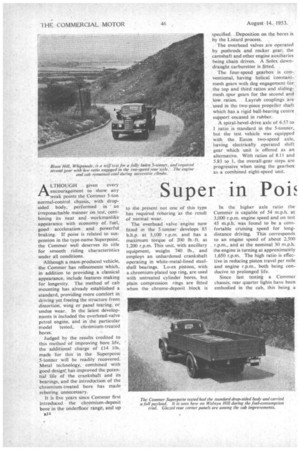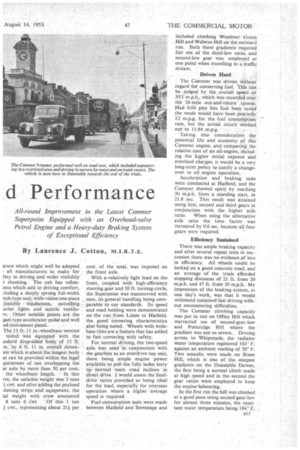Super d Performance
Page 48

Page 49

Page 50

If you've noticed an error in this article please click here to report it so we can fix it.
All-round Improvement in the Latest Commer Superpoise Equipped with an Overhead-valve Petrol Engine and a Heavy-duty Braking System of Exceptional Efficiency
By Laurence J. Cotton, M.I.R.T.E. ALTHOUGH given every encouragement to show any weak points the Commer 5-ton normal-control chassis, with .dropsided body, performed in an irreproachable manner on test, combining its neat and . workmanlike appearance with economy of. fuel, good acceleration and powerful braking. If poise is related to suspension in the type-name Superpoise, the Commer well deserves its title for smooth riding characteristics under all conditions.
-Although a mass-produced vehicle, the Commer has refinements which, in addition to providing, a classical appearance. include features making for longevity. The method of cab mounting has already established a standard, providing more comfort in driving yet freeing the structure from distortion, wing or panel tearing, or undue wear. In the latest developments is included the overhead-valve petrol engine, and in the particular model tested,. chrOrnium-treated bores.
Judged bY the results credited to this method of improving bore life, the additional charge. of £14 10s. made for this in the Superpoise 5-tonner will be readily recovered. Metal technology, combined with good design', has improved the potential life of the crankshaft and its bearings, and the introduction of the chromium-treated bore has made reboring unnecessary.
It is five years since Commer first introduced the chromium-deposit bore in the underfloor range., and up 1314 to .the.,present not one of this type has required reboring as the result of normal wear, .
The ' overhead valve engine now fitted in the 5-tanner develops 85 b.h.p. at 3,100 r.p.m. and has a maximum torque of 200 lb.-ft. at 1,200 r.p.m. This unit, with ancillary equipment, weighs 740 lb., and employs an unhardened crankshaft operating in white-metal-lined steelshell bearings. Lo-ex pistons, with a chromium-plated top ring, are used with untreated cylinder bores, but plain compression rings are fitted when the chrome-deposit block is specified. Deposition on the bores is by the Listard process. .
. The overhead valves are operated by pushrods and rocker gears the camshaft and other engine auxiliaries being chain driven. A Solex down draught carburetter is fitted. .
The four-speed gearbox is conventional, having helical bonstant• mesh gears with dog engagement for the top and third ratios and slidingmesh spur gears for the second, and . low ratios. . Layrub couplings are used in the two-piece propeller shaft which has a rigid ball-bearing centre support encased in rubber.
A spiral-bevel-drive axle of 6.57 to 1 ratio is standard in the 5-tonner, but the test vehicle was equipped with the Eaton two-speed axle, having electrically operated shift
• gearwhich unit is offered as an alternative. • With ratios of 8.11 and 5.83 .10 1, the overall-gear steps are
• progressive when using the gearbox as a combined eight-speed unit.
In the higher axle ratio the Commer is capable of 54 m.p.h. at 3,000 r.p.m. engine speed and on test 45 m.p.h. was found to be a comfortable cruising speed for longdistance driving. This corresponds to an engine speed of about 2,500 r.p.m., and at the nominal 30 m.p.h. the engine is turning at approximately 1,650 r.p.m. The high ratio is effective in reducing piston travel per mile and engine r.p.m., both being conducive to prolonged life. Since last testing a Commer chassis, rear quarter lights have been embodied in the cab, this being a ature which might well be adopted all manufacturers to make for fety in driving and wider visibility r shunting. The cab has refineents which add to driving comfort, luding a deeply sprung full-width nch-type seat, wide-vision one-piece instable windscreen, swivelling Larter lights and scuttle ventilars: Other notable. points are the gan-type accelerator pedal and well ed-instrument panel.
The 13 ft. 11 in.-wheelbase version tested was equipped with the mdard drop-sided •body of 15 It. by 6 ft. 11 in. overall dimenms which is about the longest body. at can be provided within the legal quirement of not overlapping the ar axle by more than 50 per cent.
the wheelbase length. In this rm, the unladen weight was 2 tons + cwt. and after adding the payload ttening strips• and equipment, the tal weight with crew amounted 8 torts 6, evvt. ' Of this 1 ton cwt., representing about 21i per cent. of the total, was imposed on the front axle.
With a.relatively light load on the front, coupled with high-efficiency steering gear and 50 ft. turning circle, the Superpoise was manceuvred with ease, its general handling being comparable to -car standards. Its speed and road holding were demonstrated on -the run from Luton to Hatfield, the good cornering characteristics also being noted. Wheels with widebase tints are a feature that has added to fast cornering with safety.
For normal driving, the two-speed axle was used in conjunction with the gearbox as an overdrive top unit, there being ample engine power available to pull the fully laden lorry up' normal main road inclines in direct drive. I would assess the finaldrive ratios provided as being ideal for the load, especially for overseas operation where a higher average speed is required.
Fuel-consumption tests were made between Hatfield and Stevenage and included climbing Woolmer Green Hill and Welwyn Hill on the outward run. Both these gradients required fair use of the third-low ratio, and second-low gear was employed at one point when travelling in a traffic stream.
Driven Hard •
The Qxnmer was driven without regard for conserving fuel. This can be judged by the overall speed of 30.1 m.p.h., which was recorded overthe 24-mile out-and-return course. Had 0.04 pint less fuel been saved the result would have been precisely 12 m.p.g. for the fuel consumption rate, but the actual return Worked out to 11 .4 m.p.g.
Taking into consideration the potential life and economy of this Commer engine, and comparing the relative cost of an oilengine, including the higher initial expense and overhaul charges, it would be a very long-term policy to .justify a changeover to oil engine operation.
Acceleration and braking tests were conducted at Hatfield, and the Commer showed spirit by reaching 30 m.p.h. from a standing start, in 21.8 sec. This result was attained using first, second and third gears in conjunction with the higher axle ratio. When using the alternative axle ratio the time factor was increased by 0.6 sec. because all four gears were required.
Efficiency Sustained
There was ample braking capacity and after several repeat tests in succession there was no evidence of loss in efficiency. All wheels could be locked on a good concrete road, and an average of the trials afforded stopping distances of 21 ft. from 20 m.p.h. and 47 ft. from 30 m.p.h. My impression of the braking system, in one day's work, was that it would withstand sustained fast driving without encountering difficulties.
The Commer climbing capacity was put to test on Offley Hill which warranted use of second-gear-low and Putteridge Hill where the gradient was not so severe. Driving across to Whipsnade, the radiator water temperature registered 163° F. against an ambient reading of 70° F. Two assaults were made on ,Bison Hill, which is one of the steepest gradients on the Dunstable Downs, the first being a normal climb made at high speed and in the second the gear ratios were employed to keep the engine,labouring.
In the first run the hill was climbed at a good pace using second-gear-low for alrnost three minutes, the resultant water temperature being 184° F. On the second run I endeavoured to make the Commer overheat, but
without success. The water temperature, after four minutes hard pulling at low engine speed, again registered 184° F. and the cab temperature remained normal. In addition to good under-bonnet cooling arrangements a shield is provided between the exhaust branch and engine cowl to prevent heat penetration into the cab.
There are warning notices at the top of Bison Hill concerning its gradient and advocating use of low gear for the descent. I had such implicit faith in the Commer liraking that I engaged top gear: and drove down the hill at 30 m.p.h..
Although heating the drums and increasing pedal travel this treatment did .not cause me to change my impression, and there wasstill stim-:. cierit reserve for an emergency stop. at the bottom without the pedal reaching floorboard level. I would not advocate such driving as normal. practice, but such a test-does indicate the "reserve power" in the Superpoise braking.
Judged by the notably short stopping distance, coupled with the little, nt6 effect on the braking system in the heating test, the Commer should operate for reasonably long periods between adjustment and retain a high standard of retardation in service.
This completed the trials and I drove back to Luton at a sedate 30 m.p.h. The Commer did not jib at being. driven in this style, and the
lazy driver can accelerate from 1 m.p.h. in top gear without noi! protest from the transmission objection from the engine. I consid the Commer to be amongst ti quietest running and most we behaved vehicles of the 176 which have subjected to a road test for T) Commercial Motor.




















































































